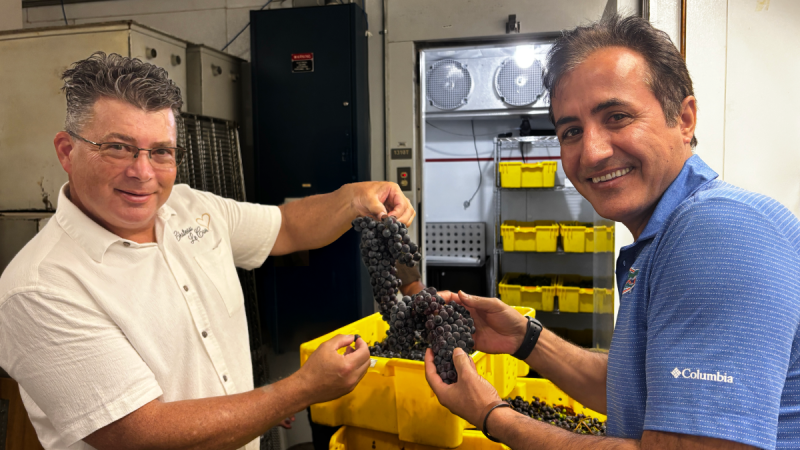
Château Le Coeur owner John Choquer, DeFuniak Springs, and Dr. Ali Sarkhosh, UF/IFAS Viticulture and Tree Fruit Specialist, have teamed up for a wine trial using the new disease-resistant grape varieties. Credit: UF/IFAS Archive
In a milestone for Florida agriculture, researchers have grown and harvested wine grapes that are resistant to the main bacterial disease that has long prevented the state from establishing a large-scale wine industry.
Researchers successfully grew five grape varieties in Citra, Florida, that are resistant to Pierce’s disease, a bacterial infection that kills the vines and shrivels the grapes. The effort, led by Ali Sarkhosh, associate professor in the UF Institute of Food and Agricultural Sciences (UF/IFAS) horticultural sciences department, produced a harvest of grapes that resulted in 13 cases of wine.

Clusters of Pierce Disease–resistant vinifera grapes harvested during UF/IFAS trials at the Plant Science Research and Education Unit in Citra, Florida. Credit: UF/IFAS Archive
Unlike the muscadine grapes typically grown in Florida, this harvest consisted almost entirely of Vitis vinifera, the same species of grapes behind world-famous wines such as Cabernet Sauvignon, Sauvignon Blanc, and Merlot. The project is supported by the Florida Department of Agriculture and Consumer Services’ Viticulture Program and carried out in collaboration with Château Le Coeur, a winery based in Defuniak Springs, in the Florida Panhandle near Destin.
“Florida’s native grape, the muscadine, is resistant to Pierce’s disease. Muscadine grapes, known for their robust flavor profile and high antioxidant content, are well-suited for producing both red and white wines, which can appeal to a diverse market. Exploring the potential of Pierce’s disease grape varieties could enhance the diversity of grapes available to Florida grape growers and wineries,” said Dr. Ali Sarkhosh, lead researcher on the project.
Florida is already the nation’s second-highest wine-consuming state, behind only California, with an industry valued at $15 billion in 2022. Yet most of the wines served are produced elsewhere, primarily in California, Oregon, and Washington.
John Choquer, the owner of Château Le Coeur, emphasized the potential for this collaboration. “There are about 38 wineries in Florida but all have been making Muscadine or fruit wine. If we are successful in growing in the area and combating Pierce’s disease effectively, it will be a strong growth industry and emerging market to agri-tourism.”
For the 2024 vintage, the team produced a wine from the hybrid grape “Erante Noir”, developed at the University of California, Davis. The wine was crafted with 75% Florida-grown fruit blended with Cabernet Sauvignon and Merlot. Fermentation products and guidance were provided by Laffort USA, whose expertise supports winemakers introducing styles relatively new to the U.S. market.
Early tastings point to a dark, fruit-forward wine with aging potential. Château Le Coeur named this debut wine “Genial”, a nod to both innovation and Florida’s own mascot, Albert (whose name shares roots with the word “genius”).
“This is not a short-term experiment,” John added. “We plan to test more Pierce’s disease-resistant and traditional vinifera varieties, refine vineyard practices, and build an enduring wine industry here in Florida.”
As vines go into the ground at Château Le Coeur, and the UF/IFAS Fruit Crop Lab continues its evaluation trials, both partners agree: Florida’s future as a wine state is no longer just an idea – it’s already bottled.
- Pierce’s Disease-Resistant Wine Grape Breakthrough Offers Hope for a Florida Wine Renaissance - November 14, 2025
- Contract Grazing: A Flexible Option for Row Crop Producers - November 14, 2025
- A Reminder That All Three Parts of the Producer Safety Net Matter - November 7, 2025
